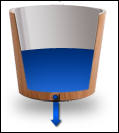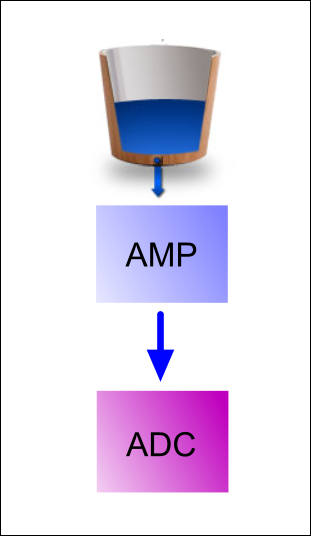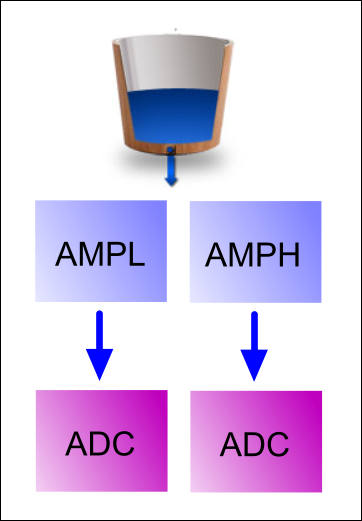
-
Everybody is working and talking about the 2.0 and now 2.1 firmware update for the GH5.
But for sure the Panasonic engeneers are alreday working on the GH6. For Panasonic claims and has prooven, that they listen to the customers, let us tell them early in the process of the development, what features we would like to see in the GH6, that can not be implemented in the GH5 through firmware update.
Let me start with a wish for a 2nd screen:
I think it is great to have the controls like waveform, histogram, sound etc. to have all the settings in sight, but as we all know, they take up a lot of space and cover up the video picture on the screen.
So my idea is, to have a second screen on the body where the screen normally rests. So that, when the normal, video screen, is flipped in, they face each other.
I would call it a "service screen", where you can have and see all the helping tools without covering the screen with the picture. All other settings like aputure, ss, ISO etc could also be shown and maybe one can also change the settings of the camera on that screeen. As you like. One should be able to assign, what you want to see on that screen.
I would make it a touch screen as well, so that the camera would have a double touch-screen, so the you can move things to the video screen if you need it, for example when you do overhead work and can not see the service screen but need the wave or sound controls. Once you are back in normal use, you can push them out of the way to the service screen again. If you do not need it, you could switch it off to save battery.
Nowadays, screens are so thin, that I doubt that it would make the camera bigger.
I think this would be a great help to have all the controls in sight, without them covering the main video screen.
Also, NO other Mirrorless or DSLR camera has that feature which would really give Panasonic another advantage over his competitors.
One could also think about transmitting the information of the service screen maybe via bluetooth to a mobile device, so one can have it in sight if a look on the camera is difficult or a 2nd person can have a look or even adjust the settings, while the camera man takes care of the framing.
What do you think about this? Would that make sense and help?
-
- Decent auto focus. Sony's A6500 auto focus is perfectly acceptable.
- 14 stops of dynamic range
- 12 bit color
In order of importance. Any one of those would be amazing haha. At this point further resolution past 4k is not needed. The GH5s is close to perfection for me.
Also the ability to turn off distortion correction and sharpening when using native lenses.
-
First: For this kind of camera it is totaly unacceptable to have such poor AF functionality. This is a basic feature and Panasonic has to deliver something as fast and accurate as Canon.
Please tell Arri that.
-
I am considering going back to Canon if this basics are not delivered.
Why not just buy one of their cheap mirrorless cams? Or even DSLR on sale?
I mean they have Dual AF now on pretty much any camera.
-
First: For this kind of camera it is totaly unacceptable to have such poor AF functionality. This is a basic feature and Panasonic has to deliver something as fast and accurate as Canon.
Second: Built in GPS sensor for geo tagging. The phone/app/Lumix Link mess is just a toy.
4K, 6K, 8K..I don't care before the basics are delivered. I am considering going back to Canon if this basics are not delivered.
-
So it seems it will happen, the 8k organic sensor:
https://www.43rumors.com/new-panasonic-8k-organic-sensor-presented-february/
but maybe just for high price cameras...
-
Support 4 channels of audio
Ohhhh... that would be nice! Would turn the GH6 even more into a "mini FS7".
The GH6 could use the Panasonic DMW-XLR1 for inputs 3/4 via the smartshoe, and tracks 1/2 would be via the stereo 3.5mm input on the camera body itself.
-
The neck strap positioning is wrong in GH5 (and others too). When hanging in neck the camera should set its position so that the lens points down. Now the camera hangs so that the lens points forward. The EVF hits chest and is in danger to get scratches and the lens collects dust and rain drops or moisture. I was in hike with GH5 and figured this is an issue. The lens hood also hit in rocks when I was climbing in difficult places.
It would also be better to change lenses outdoors if the lens points down in neck strap. Less danger of getting dust inside.
Factory made EVF cover would also be very helpful in wet or dusty places. I have now a home made EVF cover. Every other optical instrument has an EVF or ocular dust cover. Why not a camera with high resolution multi coated sensitive EVF?
-
Direct citation
The Dual Gain Architecture simultaneously provides two separate read-out paths from each pixel with different amplification. The first path contains the regular, highly amplified signal. The second path contains a signal with lower amplification, to capture the information that is clipped in the first path. Both paths feed into the camera's A/D converters, delivering a 14 bit image for each path. These images are then combined into a single 16 bit high dynamic range image."
https://www.personal-view.com/talks/discussion/16402/on-semi-sensors-power-arri-cameras
Why other manufacturers and mirrorless does not do that I just dont know, because it seems to be so simple.
Because it is capitalism, and doing so will decrease per camera margin from $3500 to say $3450.
-
So this is how Alexa increases dynamic range to 14 fstops, using ampL and ampH and merging two exposures (two different amplifications).
Why other manufacturers and mirrorless does not do that I just dont know, because it seems to be so simple.
-
Exactly. Mitch is best Panasonic representative I know. But he refused to tell how it is really done.
So, how it all works (it is simplified version, of course)
First. Initially you have photons passing filter on microlens above sensor
In a sensors quantum efficiency is the percentage of photons hitting the device's photoreactive surface that produce charge carriers. It is measured in electrons per photon or amps per watt. Since the energy of a photon is inversely proportional to its wavelength, QE is often measured over a range of different wavelengths to characterize a device's efficiency at each photon energy level. The QE for photons with energy below the band gap is zero. Photographic film typically has a QE of much less than 10%, while CCDs can have a QE of well over 90% at some wavelengths. Individual pixel where photons cause certain charge (measured in electronvolts).
Second. After exposure individual pixel can be seen as bucket filled to certain level (charge level)

Part of this charge is not caused by photons induced charge, but from "drunk" random electrons from sensitive area itself and stuff around it. The more heated sensor is, the higher is this noise level.
So, for now it is few ways to increase sensor performance - increase quantum efficiency (very hard) and decrease temperature (used in pro equipment like astro one)
Third. Now we need to get value of this charge (it is very small charge!) in digital form, preferably as accurate as possible. And it is big amount of such pixels.
So, standard way is to amplify signal and later use very fast ADC converters.

Here amplifier adds his own noise (as well as banding, due to simple fact that it is impossible to make exactly same amplifiers).
ADC are also not ideal, least significant digits can be digitized not very accurate.
Fourth. If you have large pixels, good sensor and good margins you can use other approach.

It is not unique, used in any audio recorder able to record safe track. As well as Alexa and BM cameras.
In one option of this approach you can focus on performance of ADCs and use pair of 12bit ADCs for example to get 14bit (or 16bit) data. Digital merge stage also most of the time located on CMOS sensor as it reduce data burden.
Thing that Panasonic mention under "Dual ISO" most probably means that they use very good high bit ADCs in both channels, like 14-16 bit ones (so you can switch to such ADC alone). And also are able to tell merging part that to do, so at high ISO they can use smarter merge.

 sa554.jpg119 x 133 - 4K
sa554.jpg119 x 133 - 4K
 sa555.jpg311 x 536 - 16K
sa555.jpg311 x 536 - 16K
 sa556.jpg362 x 521 - 22K
sa556.jpg362 x 521 - 22K -
Panasonic explains dual native iso:
EVA1 QUESTIONS ANSWERED
For a cinematographer that has never shot with a VariCam before, can you explain the Dual Native ISO feature?
MITCH GROSS:
Panasonic developed a process to read the sensor’s photosites in a fundamentally different way than it’s traditionally done. More information can be extracted without degrading the image. That effectively gives the imager greater sensitivity and separates the signal from the background noise. It’s essentially a different way of reading the camera sensor and it gives it two different native ISOs or sensitivities. Whereas in all others cameras, you just dial the gain up to get more sensitivity but you get a lot of noise in the image. You can also do that on the EVA1, but if you just switch between the two native ISOs, they’ll look the same as far as the amount of noise. There are two ways that one might likely want to use this. First, you can shoot with zoom lenses when normally you would have to shoot with primes because zoom lenses generally aren’t as fast. Instead of having to switch prime lenses, you have more versatility while still getting the right exposure. Another way of using Dual Native ISO is the ability to lower your light levels. In shooting with lower light levels, you will save money, time, and you can shoot with more practical lights in your surroundings. That can be for a high-end production or a more modest production where it can be used for savings, or a stylistic choice.
ftp://ftp.panasonic.com/provideo/whitepaper/questions_eva1.pdf
-
So how do you explain the fact that iso 5000 in varicam is less noise than iso 4000 and looks like iso 800?
I'll make detailed post later and explain why and how it has slightly less noise.
-
@Vitaliy_Kiselev "Again. No such thing as "dual native iso" exist outside marketers minds.
Thing they talk about is simple as hell and has nothing to do with this."So how do you explain the fact that iso 5000 in varicam is less noise than iso 4000 and looks like iso 800?
-
4 channel audio recording with adjustable ALC on 2 channels and improved sensor (lower noise, better dynamic range) for me please.
-
Imagine the GH6 with 4096x2160 9megapixel 4k sensor with dual native iso = low light/available light monster!
Again. No such thing as "dual native iso" exist outside marketers minds.
Thing they talk about is simple as hell and has nothing to do with this.
-
Imagine the GH6 with 4096x2160 9megapixel 4k sensor with dual native iso = low light/available light monster!
-
It is really bad idea. Monitoring means that issue you hear is issue with recording, not with horrible Bluetooth performance.
I agree it feels risky and I don't know the answer, but the question would be if newer tech like bluetooth in it's last iteration is stable enough that it might be a usable option. I know for myself that there are shooting scenarios where I don't monitor at all, but I would have monitored if I could have used wireless headphones. Ofcourse also having wired monitoring as a safe fallback.
-
Support wireless monitoring of audio via bluetooth headset
It is really bad idea. Monitoring means that issue you hear is issue with recording, not with horrible Bluetooth performance.
-
Very good idea. A wireless audio receiver with two simultaneous channels integrated in camera would be awesome. It would avoid the need of extra equipment and unreliable cable conections. It would allow the use of two lavalier mics at same time or two shotguns. Nice!
-
Make the GH6 even easier to use. Should work better in semi-auto modes (so content creators can focus more on framing and what's going on in front of camera) and ofcourse still please the manual crowd.
I second many of the good suggestions already, including them and some other in the list below:
General:
- Reliable and fast AF
- Better low-light performance
Audio:
- Support 4 channels of audio
- Support wireless monitoring of audio via bluetooth headset
Connectivity and interface:
- Better utilisation of smartphone as second screen
- Rethink how we offload and log footage. Smart tagging etc.
Experimental ideas:
- Cooperate with Aputure (or similar) to make the Vari-ND DEC Adapter (or similar) work perfect; strip away all external boxes and eliminate need for external power, make the Canon lenses Autofocus smooth with GH6 PDAF, buttons an adaptor and make custom config button on Panasonic camera to adjust variND on adaptor.
- Integrate wireless audio reciever in camera (aka Rode Wirelink type tech) - I really miss keeping having wireless audio, while keeping camera compact stealth.
-
There are some explanations online saying the dual native iso works with two different analog circuits in the sensor before the analog/digital conversion, one circuit for low iso and other circuit for high iso.
People who tested the Varicam said that the iso 5000 (dual native) is less noise than iso 4000, and looks the same as iso 800.
The EVA1 also has dual native iso, so the future GH6 with 8k sensor can have it.
-
Dual Native ISO would also be nice if possible.
No such thing as "Dual Native ISO" exist, it is marketing bullshit. I'll later make post about thing they call such.
Global shutter leads to significant issues with noise and hence - DR, plus it'll be sensor price hike.
-
Dual Native ISO can solve the noise problem in 8k sensor.
-
Multi aspect sensor would be nice. GH2 was the last to have it.
Dual Native ISO would also be nice if possible.
Global Shutter version would be a dream.
-
@apefos no it's not! There are advantages to more resolution and reducing to output size see resolution tests sony 6500. They should simply have one camera that does it all very well at the top end. For stills there are simply better alternatives and probably always will be. As far as 176 mp mode are you serious lol.
Howdy, Stranger!
It looks like you're new here. If you want to get involved, click one of these buttons!
Categories
- Topics List23,992
- Blog5,725
- General and News1,354
- Hacks and Patches1,153
- ↳ Top Settings33
- ↳ Beginners256
- ↳ Archives402
- ↳ Hacks News and Development56
- Cameras2,367
- ↳ Panasonic995
- ↳ Canon118
- ↳ Sony156
- ↳ Nikon96
- ↳ Pentax and Samsung70
- ↳ Olympus and Fujifilm101
- ↳ Compacts and Camcorders300
- ↳ Smartphones for video97
- ↳ Pro Video Cameras191
- ↳ BlackMagic and other raw cameras116
- Skill1,960
- ↳ Business and distribution66
- ↳ Preparation, scripts and legal38
- ↳ Art149
- ↳ Import, Convert, Exporting291
- ↳ Editors191
- ↳ Effects and stunts115
- ↳ Color grading197
- ↳ Sound and Music280
- ↳ Lighting96
- ↳ Software and storage tips266
- Gear5,420
- ↳ Filters, Adapters, Matte boxes344
- ↳ Lenses1,582
- ↳ Follow focus and gears93
- ↳ Sound499
- ↳ Lighting gear314
- ↳ Camera movement230
- ↳ Gimbals and copters302
- ↳ Rigs and related stuff273
- ↳ Power solutions83
- ↳ Monitors and viewfinders340
- ↳ Tripods and fluid heads139
- ↳ Storage286
- ↳ Computers and studio gear560
- ↳ VR and 3D248
- Showcase1,859
- Marketplace2,834
- Offtopic1,320






